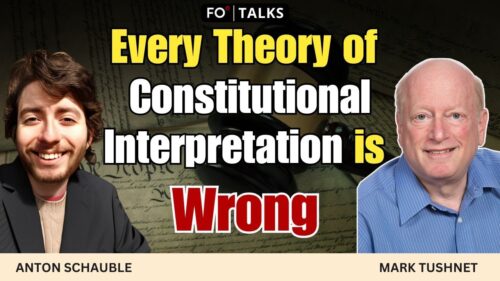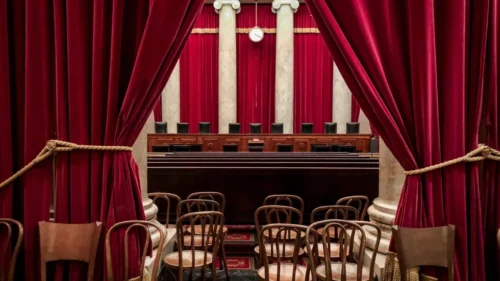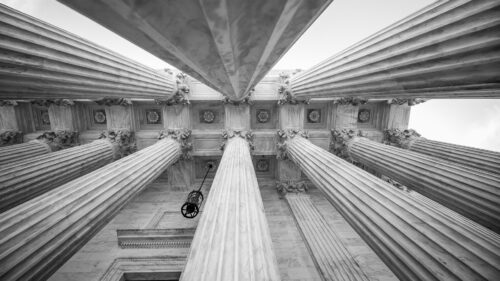Originalists and living constitutionalists currently debate how to interpret the constitution of the United States. Far from remaining in a purely juridical or scholarly context, this has become a political issue with major implications for the daily life of US citizens. Some context is needed to understand what is at stake.
Written constitutions are a product of the 18th century
Written constitutions are relatively new. They emerged from the 18th-century liberal revolutions, which sought to guarantee citizens’ rights and limit rulers’ power. French constitutionalist Georges Burdeau writes: “For 18th-century publicists [writers on public affairs], it became a true dogma that the rules that governed the functioning of the State had to be systematically incorporated in a written text.”
Before that, customary constitutions were the norm. These were a disordered collection of judicial rulings, statutes, tradition, authoritative works, and general principles. They were uncodified and rooted in custom. In essence, they were timeless.
Typical examples include the German Constitution before 1870 and the current British Constitution. In his 1802 book The German Constitution, German philosopher Georg Wilhelm Friedrich Hegel pointed out how ancient norms still governing German life became obstacles to a modern, unified German state. Germany was a patchwork of states whose existence the constitution protected.
The English constitutional system derives from rights defined and guaranteed by courts. Common law is complemented by a diverse set of statutes never codified in a single text. These include the Magna Carta of 1215, the Habeas Corpus Act of 1679, and the Bill of Rights of 1689. Traditions, unwritten rules, and works like Walter Bagehot’s The English Constitution also contribute to this heterogeneous system.
By contrast, the US constitution of 1787 and the French constitution of 1791 were the first written constitutional texts drafted to govern their respective nations. Yet they followed different paths. The US constitution has remained largely intact, aside from its amendments. France, however, replaced its 1791 constitution the following year. Between 1791 and 1958, France adopted thirteen constitutions.
This pattern reflects the view that constitutions must change with fundamental political shifts. Should the far-right National Rally win the 2027 French presidential elections, it would likely try to replace the 1958 Gaullist constitution with a new one tailored to its program.
The US constitution quietly blends rigidity with silent adaptation over time
Although the US constitution has remained largely unchanged, in practice it sits somewhere between a written constitution and the British tradition. US courts, customs, and interactions between branches of government influence its application. For example, the relationship between the president and Congress often relies on implicit or inherent powers, where mutual acquiescence can create rights not explicitly granted by the constitution.
Still, most countries have embraced the idea that the fundamental law should evolve with society. Spanish intellectual José Ortega y Gasset argued that constitutions should reflect “pure life,” or else they become “corpses of fulfilled history.”
Austrian jurist Hans Kelsen distinguished between the normative and material nature of constitutions. The former refers to their formal legal structure. The latter addresses the political and social forces shaping the values embedded in the constitution.
After World War I, constitutional preambles became common. These sections express the political and social goals that guide the constitution. Rather than existing in a timeless legal vacuum, they present an aspirational vision.
But extremes are dangerous. Binding society to the corpse of its past, as Hegel and Ortega y Gasset warned, is just as harmful as writing constitutions to suit the regime of the day. The US constitution has historically avoided both pitfalls. It represents a midpoint between these extremes.
Originalists now seek to freeze American law in 1787
The constitution written for thirteen newly independent agricultural colonies still governs a vast and populous country. This endurance is remarkable. But how did it happen?
Legal scholar David A. Strauss explains:
A living constitution is one that evolves, changes over time, and adapts to new circumstances, without being formally amended… The nation has grown in territory and its population has multiplied several times over. Technology has changed, the international situation has changed, the economy has changed, social mores have changed, all in ways that no one could have anticipated when the constitution was drafted. So, it seems inevitable that the constitution will change too… On the other hand… The constitution is supposed to be a rock-solid foundation, the embodiment of our most fundamental principles… So it seems we want to have a constitution that is both living, adapting, and changing and, simultaneously, invincibly stable and impervious to human manipulation. How can we escape this predicament? The good news is that we have mostly escaped it, albeit unselfconsciously. Our constitutional system… has tapped into an ancient source of law. That ancient kind of law is common law. The common law is a system built not on an authoritative, foundational, quasi-sacred text like the constitution. Rather the common law is built out of precedents and traditions that accumulate over time. Our constitutional system has become a common law system, one in which precedent and past practices are, in their own way, as important as the written constitution itself. A common law constitution is a “living” constitution.
Unfortunately, an ultra-conservative shift in the US has elevated a school of thought called originalism. Unlike the living constitution approach, originalists believe that the constitution must be interpreted based on the intentions of its 1787 framers. Legal scholar Lawrence B. Solum summarizes this view: “Originalists argue that the meaning of the constitutional text is fixed and that it should bind constitutional actors.”
This is akin to religious fundamentalism, which insists on literal interpretation of sacred texts. Five of the nine current US Supreme Court justices explicitly adhere to originalism, while a sixth does so implicitly. This tilts the Court heavily in that direction.
Restricting constitutional interpretation to 18th-century intentions effectively turns back the clock. From Kelsen’s perspective, this would reflect a purely normative view of the constitution. The material view — which should reflect political and social values — is reduced to the ideas of Alexander Hamilton, James Madison, and John Jay.
From representing the best of both worlds, the US constitution now risks representing the worst.
The views expressed in this article are the author’s own and do not necessarily reflect Fair Observer’s editorial policy.
Support Fair Observer
We rely on your support for our independence, diversity and quality.
For more than 10 years, Fair Observer has been free, fair and independent. No billionaire owns us, no advertisers control us. We are a reader-supported nonprofit. Unlike many other publications, we keep our content free for readers regardless of where they live or whether they can afford to pay. We have no paywalls and no ads.
In the post-truth era of fake news, echo chambers and filter bubbles, we publish a plurality of perspectives from around the world. Anyone can publish with us, but everyone goes through a rigorous editorial process. So, you get fact-checked, well-reasoned content instead of noise.
We publish 3,000+ voices from 90+ countries. We also conduct education and training programs
on subjects ranging from digital media and journalism to writing and critical thinking. This
doesn’t come cheap. Servers, editors, trainers and web developers cost
money.
Please consider supporting us on a regular basis as a recurring donor or a
sustaining member.
Will you support FO’s journalism?
We rely on your support for our independence, diversity and quality.









Comment
I have the greatest regard for Alfredo Toro Hardy. He writes with erudition and reflection. I am honored that is one of our authors.